

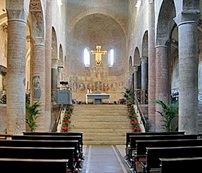
The church is in the form of an unusually high central nave and two lower aisles, with a presbytery raised over a crypt.
Bishop Paolo Bonavisa remodelled the interior in 1744, at which point:
-
✴the floor level of the nave and aisles was raised;
-
✴most of the side chapels that had been built at various times were demolished;
-
✴the walls were covered in stucco decoration; and
-
✴a series of new altars was built along the aisles.
The stucco decoration was removed in 1947-50 to reveal important frescoes underneath. The steps that now lead up to the apse were built as part of this remodelling.
Counter-Facade
Fresco Fragment (12th century)

-
✴The inscription between the scenes suggests that the upper one depicted the martyrdom of a saint, perhaps St Gregory of Spoleto.
-
✴The insertion of the left portal obliterated most of the lower scene.
Scenes from the Passion (12th century)
These damaged frescoes on the counter-façade were probably executed soon after the completion of the construction of the church. They depict:
-
✴the Crucifixion (above the portal, to the left), of which only part of the crucifixion of one of the thieves and the head of the Virgin survive;
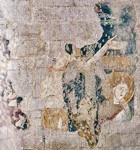
-
✴the Deposition (to the left of the portal), of which only the figure of a grieving woman (perhaps the Virgin) survives; and
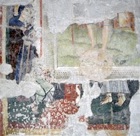
-
✴two scenes to the right of the portal:
-
•the burial in the sepulchre; and

-
•the empty tomb.
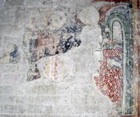
St Catherine of Alexandria (14th century)
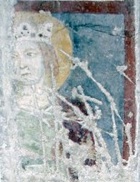
Lower Left Wall
Pilgrim saint (15th century)
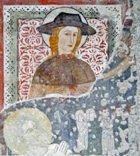
Crucifixion and female saint (early 13th century)
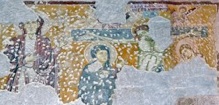
This damaged fresco represents the Crucifixion with the Virgin and St John the Evangelist. A female saint to the left looks at the viewer and points towards the main scene. This work represents a relatively early example of the iconography of Christus Patiens, the dying Christ on the cross.
Inscription (ca. 1079)

Cappella del Sacramento (ca. 1844)
This chapel was the only one of the side chapels that was not walled up in 1947-50. The recent restoration has uncovered its original monochrome frescoes.
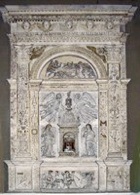
The relief at the centre of the predella depicts the martyrdom of St Stephen. Those to the left and right of the it outline the foundation story of the hospice:
-
✴a star appears over a well outside San Gregorio, which leads to the discovery of the bodies of abandoned babies that have been thrown into it; and
-
✴this causes Bishop Bartolomeo Accoramboni to establish what became known as the Ospedale della Stella (in 1254).
Maesta with saints (14th century)
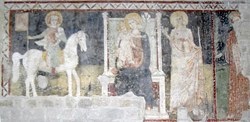
This fresco depicts the Madonna and Child enthroned with:
-
✴a saint on horseback (usually identified as St Pontian) on the left; and
-
✴St Lucy, holding a candle, on the right.
The contemporary fresco to the right depicts St Catherine of Alexandria.
Inscription (1596)
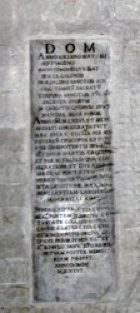
-
✴The original inscription recorded the consecration of the church of SS Gregory and Barattale in 1146 and the granting of indulgences.
-
✴The present inscription adds that Bishop Paolo Sanvitale ordered the transcription.
Madonna del latte (14th century)
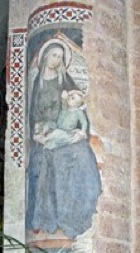
Upper Left Wall
SS Antony Abbot and Leonard (15th century)
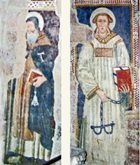
Madonna del latte (14th century)
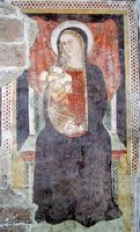
Fragments of a column (ca. 900)
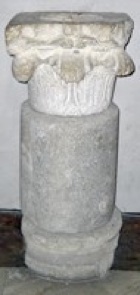
Madonna di Loreto and saints (1528)
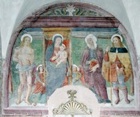
-
✴St Sebastian stands to the left; and
-
✴a female saint (thought to be St Abbondanza) and St Roch stand to the right.
The inscription gives the date and the name of the lady who commissioned the work: Johanna, once the wife of Salvatore Berardi. The presence of the plague saints suggests that Salvatore had died of this disease.
Blessed Mattia da Spoleto and St Gregory (14th and 15th centuries)
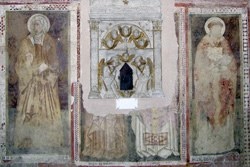
These figures are identified by inscription:
-
✴Blessed Mattia (14th century) on the left;
-
✴figures of both saints (15th century) in the middle, ruined by the subsequent insertion of a tabernacle (see below); and
-
✴St Gregory (15th century) on the left.
The Blessed Mattia (or Mactia) is depicted as an Augustinian nun. Her presence in the fresco here suggests that she became the object of a local cult. There are at least three possible candidates of this name who lived in Spoleto in the early 14th century.
Tabernacle (15th century)
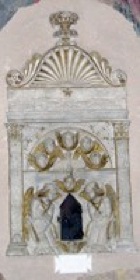
Left Apsidal Chapel
A Roman funerary cippus (ca. 100 AD) serves as a base for the altar in this chapel.
Madonna del latte (ca. 1400)
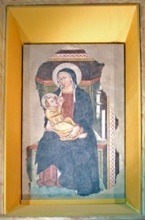
Presbytery and Apse
St James Major and Christ (late 14th century)
These frescoes, which are on the columns on the at the top of the steps leading to the presbytery, are attributed to the Maestro di Santa Elisabetta:
-
✴St James Major, with his attributes a a pilgrim, is on the column on the left.
-
✴Christ blessing is on the column on the right. The inscription on the open Gospel translates" I am the way, the truth, and the life" (John 14:6).
Pavement (12th century)
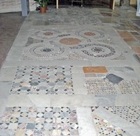
Inscribed Cippus (6th century)
This cippus, which was retrieved from the left wall to form the base of the high altar, is now in the presbytery [where ??]. It bears inscriptions on two sides:
-
✴one records the burial of Vitalis, a freed slave of Felice who worked as a farmer; and
-
✴the other records Stefania, a peasant owned by Domitius, who is referred to as "vir spectabilis", the title of an important official at the time of the late Roman Empire.
This is possibly the official called Domitius who received flooded land in Spoletium from the Emperor Theoderic (493–526) on condition that he arranged for it to be drained.
Frescoes on the apse wall (12th century)
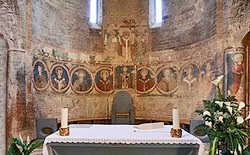
These damaged frescoes,like those on the counter-façade, were probably executed soon after the completion of the construction of the church. They were discovered under plaster in the early 20th century when a later fresco of the Madonna and Child (see below) was detached.
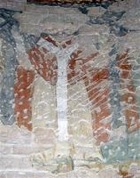
-
✴The scene of the Madonna and Child with angels (between the windows) is no longer visible.
-
✴Little remains of the central register, which depicted standing saints identified by inscriptions. The central three, which are the best preserved, include:
-
•St Barattale;
-
•St Gregory (illustrated here); and
-
•an unidentified saint.
-
✴The bottom register contains a series of unidentified bishop saints. They are framed in tondi, except for the larger central figure, which has a rectangular frame.
Crucifix(2006)
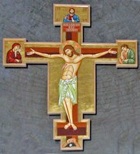
St Catherine of Alexandria (14th century)

Right Apsidal Chapel
A Roman funerary cippus (ca. 200 AD) serves as a base for the altar in this chapel.
Madonna and Child enthroned (14th century)
This detached fresco, which was originally in the crypt, was moved here in 1950.
Upper Right Wall
Madonna and Child enthroned (ca. 1388)
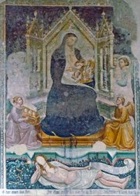
Unusually the fresco shows the body of Eve in a shroud at the feet of the Madonna, to underline her role as the second Eve. Eve's face is now blank and may never have been painted. This iconography, which is discussed on the website Display and Devotion, was probably first introduced by Ambrogio Lorenzetti in his Maesta (1338-40) in the Montesiepi Chapel, San Galgano.
Lower Right Wall
Christ Blessing (14th century)
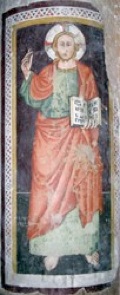
Madonna and Child enthroned (13th century)
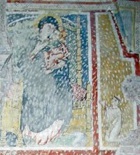
St Gregory and the Blessed Mattia (15th century)

Fragment from a Maestà (1296)
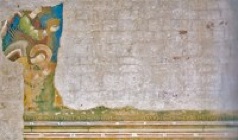
All that survives of this important fresco is a fragment depicting two angels and part of the long inscription that includes the date. The angels seem to have been inspired by those in the Rucellai Madonna (ca. 1285) by Duccio di Buoninsegna, which is now in the Galleria degli Uffizi, Florence.
Unidentified saint (15th century)
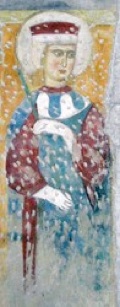
Reliquary of the Blessed Christina Semenzi (17th century)
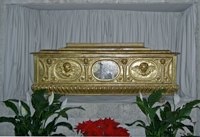
This gilded wooded reliquary contains the relics of Blessed Christina Semenzi (died 1458). The relics, which were originally in San Nicolò, were moved to the Madonna di Loreto in 1803 and to this location in 1921.
In the central elliptical field on the side of the reliquary, the blessed Christine is depicted adoring a Crucifix.
Detached frescoes (14th and 15th centuries)
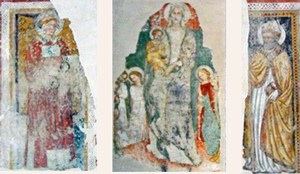
The detached frescoes now in the last bay of the right wall include four that are attributed to the Maestro di Eggi:
-
✴Christ in the garden (not illustrated here);
-
✴St Leonard;
-
✴the Madonna di Loreto; and
-
✴St Martin
The collection also includes:
-
✴an interesting fresco (15th century) of St Bartholomew and a female saint in which St Bartholomew, who has been flayed alive, holds the skin from his face; and
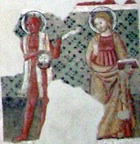
-
✴a large fragment of a figure of St John the Baptist (14th century)
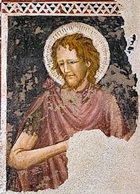
Sacristy
Two reliquary busts associated with the relics of St Gregory of Spoleto are preserved in the sacristy:
-
✴a gilded wooden reliquary bust (17th century), which has an inscription that records the gift of the cranium from Cardinal Giovanni Evangelista Pallotta to Prior Decio Gelosi in 1619; and
-
✴a reliquary bust (ca. 1755), which is attributed to Francesco Giardoni, into which Bishop Paolo Bonavisa transferred this relic in 1755.
Art from the Church
St Joseph and the Baby Jesus (ca. 1740)
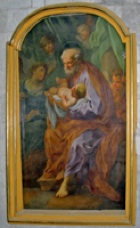
Return to the home page on San Gregorio Maggiore.
Proceed to page the crypt.
Return to Monuments of Spoleto.
Return to Walk III.

